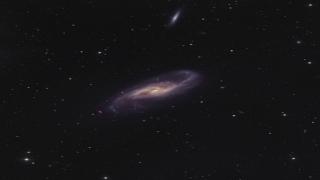Bibcode
Bouquin, A. Y. K.; Gil de Paz, Armando; Boissier, Samuel; Muñoz-Mateos, Juan-Carlos; Sheth, Kartik; Zaritsky, Dennis; Laine, Jarkko; Gallego, Jesús; Peletier, Reynier F.; Röck, B. R.; Knapen, J. H.
Bibliographical reference
The Astrophysical Journal Letters, Volume 800, Issue 1, article id. L19, 6 pp. (2015).
Advertised on:
2
2015
Citations
16
Refereed citations
14
Description
We obtained GALEX FUV, NUV, and Spitzer/IRAC 3.6 μm photometry for
\gt 2000 galaxies, available for 90% of the S4G sample. We
find a very tight GALEX blue sequence (GBS) in the (FUV–NUV)
versus (NUV–[3.6]) color–color diagram, which is populated
by irregular and spiral galaxies, and is mainly driven by changes in the
formation timescale (τ) and a degeneracy between τ and dust
reddening. The tightness of the GBS provides an unprecedented way of
identifying star-forming galaxies and objects that are just evolving to
(or from) what we call the GALEX green valley (GGV). At the red end of
the GBS, at (NUV–[3.6]) \gt 5, we find a wider GALEX red sequence
(GRS) mostly populated by E/S0 galaxies that has a perpendicular slope
to that of the GBS and of the optical red sequence. We find no such
dichotomy in terms of stellar mass (measured by {{M}[3.6]})
since both massive ({{M}\star }\gt
{{10}11}{{M}ȯ }) blue- and red-sequence
galaxies are identified. The type that is proportionally more often
found in the GGV is the S0-Sa’s, and most of these are located in
high-density environments. We discuss evolutionary models of galaxies
that show a rapid transition from the blue to the red sequence on a
timescale of 108 yr.
Related projects

Spiral Galaxies: Evolution and Consequences
Our small group is well known and respected internationally for our innovative and important work on various aspects of the structure and evolution of nearby spiral galaxies. We primarily use observations at various wavelengths, exploiting synergies that allow us to answer the most pertinent questions relating to what the main properties of
Johan Hendrik
Knapen Koelstra